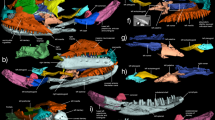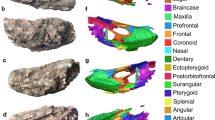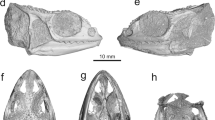Abstract
THE amphisbaenians, lizards and snakes constitute a monophyletic group, the Squamata. Although amphisbaenians are known to have occurred in the Mesozoic1,2, their remains are rare and fragmentary. The oldest and most primitive known skull of an amphisbaenian is from the Eocene of North America3 and differs little from that of modern taxa4–9. A substantial structural gap exists between this skull and that of the several possible sister groups8,10. No derived features uniquely linking amphisbaenians to any other group of the Squamata have been recognized, so the relationship of amphisbaenians is uncertain11,12. We report here on the late Cretaceous lizard-like amphisbaenian represented by well-preserved cranial and postcranial material from the Bayan Mandahu redbeds of the Gobi Desert, Inner Mongolia, China. This material documents the oldest and most primitive amphisbaenian yet known, and permits a re-evaluation of the relationship between the amphisbaenians and other squamates.
This is a preview of subscription content, access via your institution
Access options
Subscribe to this journal
Receive 51 print issues and online access
$199.00 per year
only $3.90 per issue
Buy this article
- Purchase on Springer Link
- Instant access to full article PDF
Prices may be subject to local taxes which are calculated during checkout
Similar content being viewed by others
References
Borsuk-Bialynicka, M. Cretac. Res. 12, 607–608 (1991).
Astibia, H. et al. Terra Res. 2, 460–466 (1991).
Berman, D. Copeia 4, 704–721 (1973).
Gilmore, C. Mem. natn. Acad. Sci. 22, 1–197 (1928).
Taylor, E. H. Kans. Univ. Sci. Bull. 34, 521–579 (1951).
Berman, D. J. Paleont. 50, 165–174 (1976).
Berman, D. J. Paleont. 51, 986–991 (1977).
Zangerl, R. Am. Midl. Nat. 33, 764–780 (1945).
Gans, C. Bull. Am. Mus. Nat. Hist. 119, 129–204 (1960).
Gans, C. Trans, zool. Soc. Lond. 34, 347–416 (1978).
Estes, R., Queiroz, K. & Gauthier, J. in Phylogenetic Relationships of the Lizard Families (eds Estes, R. & Pregill, G.) 120–280 (Stanford Univ. Press, California, 1988).
Rieppel, O. in The Phytogeny and Classification of the Tetrapods Vol. 1 (ed. Benton, M. J.) 261–294 (Clarendon, Oxford, 1988).
Jerzykiewicz, T. et al. Can. J. Earth Sci. (in the press).
Rage, J.-C. Pour La Sci. 1982, 16–27 (1982).
Greer, A. E. J. Herpetol. 19(1), 116–156 (1985).
Presch, W. in Phylogenetic Relationships of the Lizard Families (eds Estes, R. & Pregill, G.) 471–492 (Stanford Univ. Press, California, 1988).
Bogert, C. Nat. Hist. 73, 17–24 (1964).
Rieppel, O. J. Zool. 195, 493–528 (1981).
Böhme, W. in Handbuch der Reptilien und Amphibien Europas Vol. 1 (ed. Böhme, W.) 275–276 (Akademische Verlagsgesellschaft, Wiesbaden, 1981).
Schwenk, K. In Phylogenetic Relationships of the Lizard Families (eds Estes, R. & Pregill, G.) 569–598 (Stanford Univ. Press, California, 1988).
Sulminski, A. Palaeont. pol. 33, 25–102 (1975).
Estes, R. Handbuch der Paläoherpetologie Vol. 10A (Fischer, Stuttgart, 1983).
Rieppel, O. Zool. J. Linn. Soc. 89, 41–62 (1987).
Rage, J.-C. Handbuch der Paläoherpetologie Vol. 11 (Fischer, Stuttgart, 1984).
Bellairs, A.d'A. & Gans, C. Nature, 302, 243–244 (1983).
Eberth, D. A. Can. J. Earth Sci. (in the press).
Author information
Authors and Affiliations
Rights and permissions
About this article
Cite this article
Wu, Xc., Brinkman, D., Russell, A. et al. Oldest known amphisbaenian from the Upper Cretaceous of Chinese Inner Mongolia. Nature 366, 57–59 (1993). https://doi.org/10.1038/366057a0
Received:
Accepted:
Issue Date:
DOI: https://doi.org/10.1038/366057a0
This article is cited by
-
Amphisbaenians from the European Eocene: a biogeographical review
Palaeobiodiversity and Palaeoenvironments (2012)
-
Eocene lizard from Germany reveals amphisbaenian origins
Nature (2011)
Comments
By submitting a comment you agree to abide by our Terms and Community Guidelines. If you find something abusive or that does not comply with our terms or guidelines please flag it as inappropriate.



